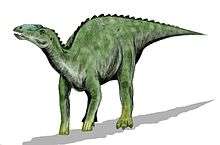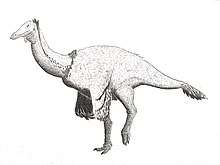Cerro del Pueblo Formation
The Cerro del Pueblo Formation is a geological formation in Coahuila, Mexico whose strata date back to the Late Cretaceous. Dinosaur remains are among the fossils that have been recovered from the formation.[1] The formation has been dated to between 72.5 Ma and 71.4 million years old.[2]
| Cerro del Pueblo Formation Stratigraphic range: Campanian-Maastrichtian, 72.5–71.4 Ma | |
|---|---|
 | |
| Type | Geological formation |
| Unit of | Difunta Group |
| Underlies | Cerro Huerta Formation |
| Overlies | Parras Shale |
| Thickness | 160 m |
| Lithology | |
| Primary | Mudstone, Sandstone |
| Other | Siltstone, Conglomerate, Limestone |
| Location | |
| Region | North America |
| Country | |
| Extent | |
Vertebrate paleofauna
Dinosaurs
Color key
|
Notes Uncertain or tentative taxa are in small text; |
| Dinosaurs reported from the Cerro del Pueblo Formation | ||||||
|---|---|---|---|---|---|---|
| Genus | Species | Location | Member | Material | Notes | Images |
|
Indeterminate |
 Kritosaurus navajovius | |||||
|
C. magnacuerna[3] |
Middle |
CPC 276, a partial skeleton (including several skull elements) of an adult, CPS 277, possibly a juvenile.[3] |
||||
|
G. sp. |
Reclassified as belonging to the new genus Latirhinus.[4] | |||||
|
K. navajovius[5] |
IGM 6685, a fragmentary skull represented by the rostral regions of both premaxillae and probably the rostralmost portions of the maxillae.[5] |
A kritosaurin hadrosaurid, referred to K. navajovius. | ||||
|
L. uitstlani[4] |
IGM 6583, a fragmentary skeleton including a partial right nasal, and postcranial elements.[4] |
|||||
|
Indeterminate |
||||||
| Paraxenisaurus[6] | P. normalensis[6] | The remains of multiple individuals are known. Known remains include vertebrae (backbones), as well as hand and foot elements.[6] | A deinocheirid theropod. | |||
|
V. coahuilensis |
Middle |
|||||
Pterosaurs
| Pterosaurs of the Cerro del Pueblo Formation | ||||
|---|---|---|---|---|
| Taxa | Presence | Description | Images | |
|
Ichnogenus: |
|
| ||
Turtles
| Turtles of the Cerro del Pueblo Formation | ||||
|---|---|---|---|---|
| Taxa | Description | Images | ||
|
Euclastes coahuilaensis |
Sea turtle, reclassified as belonging to the new genus Mexichelys.[8] | |||
|
Mexichelys coahuilaensis[8] |
New genus for Euclastes coahuilaensis, sea turtle. | |||
See also
- List of dinosaur-bearing rock formations
References
- Weishampel, David B; et al. (2004). "Dinosaur distribution (Late Cretaceous, North America)." In: Weishampel, David B.; Dodson, Peter; and Osmólska, Halszka (eds.): The Dinosauria, 2nd, Berkeley: University of California Press. Pp. 574-588. ISBN 0-520-24209-2.
- Loewen, M. A., Sampson, S. D., Lund, E. K., Farke, A. A., Aguillón-Martínez, M. C., de Leon, C. A., ... & Eberth, D. A. (2010). Horned dinosaurs (Ornithischia: Ceratopsidae) from the Upper Cretaceous (Campanian) Cerro del Pueblo Formation, Coahuila, Mexico. New perspectives on horned dinosaurs. Edited by MJ Ryan, BJ Chinnery-Allgeier, and DA Eberth. Indiana University Press, Bloomington, 99-116. Chicago
- Loewen, M.A., Sampson, S.D., Lund, E.K., Farke, A.A., Aguillón-Martínez, M.C., de Leon, C.A., Rodríguez-de la Rosa, R.A., Getty, M.A., Eberth, D.A., 2010, "Horned Dinosaurs (Ornithischia: Ceratopsidae) from the Upper Cretaceous (Campanian) Cerro del Pueblo Formation, Coahuila, Mexico", In: Michael J. Ryan, Brenda J. Chinnery-Allgeier, and David A. Eberth (eds), New Perspectives on Horned Dinosaurs: The Royal Tyrrell Museum Ceratopsian Symposium, Indiana University Press, 656 pp.
- Prieto-Márquez, Albert; Serrano Brañas, Claudia Inés (2012). "Latirhinus uitstlani, a 'broad-nosed' saurolophine hadrosaurid (Dinosauria, Ornithopoda) from the late Campanian (Cretaceous) of northern Mexico". Historical Biology. 24 (6): 607–619. doi:10.1080/08912963.2012.671311.
- Prieto-Márquez, A. (2013). "Skeletal morphology of Kritosaurus navajovius (Dinosauria:Hadrosauridae) from the Late Cretaceous of the North American south-west, with an evaluation of the phylogenetic systematics and biogeography of Kritosaurini". Journal of Systematic Palaeontology. 12 (2): 133–175. doi:10.1080/14772019.2013.770417.
- Serrano-Brañas, Claudia Inés; Espinosa-Chávez, Belinda; Maccracken, S. Augusta; Gutiérrez-Blando, Cirene; de León-Dávila, Claudio; Ventura, José Flores (April 2020). "Paraxenisaurus normalensis, a large deinocheirid ornithomimosaur from the Cerro del Pueblo Formation (Upper Cretaceous), Coahuila, Mexico". Journal of South American Earth Sciences. 101: 102610. doi:10.1016/j.jsames.2020.102610.
- Lockley, M.; Harris, J.D.; and Mitchell, L. 2008. "A global overview of pterosaur ichnology: tracksite distribution in space and time." Zitteliana. B28. p. 187-198. ISSN 1612-4138.
- James F. Parham; Nicholas D. Pyenson (2010). "New Sea Turtle from the Miocene of Peru and the Iterative Evolution of Feeding Ecomorphologies since the Cretaceous". Journal of Paleontology. 84 (2): 231–247. doi:10.1666/09-077R.1.
- Gudiño Maussán, José L.; Aguilar, Felisa J.Hernández; Hernández-Rivera, René (2018). "Aplicación de fotogrametría digital para el registro de las huellas de dinosaurio de la Formación Cerro del Pueblo (Campaniano tardío), Coahuila, México" (PDF). Boletín de la Sociedad Geológica Mexicana. 70 (2): 307–324. doi:10.18268/BSGM2018v70n2a3.

